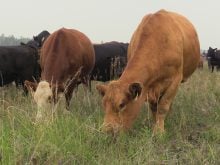This cattle market information is selected from the weekly report from Canfax, a division of the Canadian Cattlemen’s Association. More market information, analysis and statistics are available by becoming a Canfax subscriber by calling 403-275-5110 or at www.canfax.ca.
Rain reduces cow pressure
Alberta and Ontario cow prices have moved in opposite directions lately. Alberta cow prices are trading $2 per cwt. shy of their highs back in early May, while Ontario cow prices have been setting new annual highs on a weekly basis. Averaging more than $117 per cwt., Ontario cow prices are at the highest point since August 2015.
Read Also

No special crop fireworks expected
farmers should not expect fireworks in the special crops market due to ample supplies.
With recent rains across much of the Prairies, marketing pressure has moderated and non-fed volumes were much lighter through auction facilities last week. After trading at a premium to the U.S. utility cow market for April and most of May, Alberta prices have moved back to a discount.
Over the previous four weeks, western Canadian cow slaughter is eight percent lower than last year, while eastern Canadian cow slaughter is up 12 percent. New label requirements proposed by Health Canada for ground beef would make Canada the only country in the world to indicate beef is high in saturated fats. Extra cost on labeling and potential lost consumer demand is concerning for the industry.
Feds set new high
Alberta fed cattle prices set a new annual high last week with the strongest weighted average prices since May 2017. Steer trade volumes were moderate but heifer volumes were too slight to fully establish a weekly price trend.
Most trade was reported steady to $4 per hundredweight higher than the previous week dressed in a tight $292-$294 per cwt. range. Weighted average steer prices firmed $1.50 per cwt. higher than the previous week to $174.59 per cwt.
Kill schedules for cattle traded last week were reported for the weeks of July 18 and 25. Western Canadian fed slaughter for the week ending June 11 realigned seasonally 13 percent larger than the previous week to 46,731 head. Year to date western fed slaughter was five percent larger at 984,730 head.
Canadian fed cattle/cow exports to the United States for the week ending June 4 were four percent larger than the previous week at 8,268 head and were 108 percent larger than a year ago. Year to date export volume was 17 percent larger at 223,499 head.
Ontario saw light to moderate volume trade last week, with prices fully steady with the previous week at $320 per cwt. delivered.
In the U.S., light southern trade saw prices firm US$2-$3 per cwt. higher than the previous week in a full $136-$140 per cwt. range. Most northern live trade was $3-$4 per cwt. higher than the previous week from $145-$149 per cwt.
Feeder market steady
Despite seasonally lighter auction volumes, the market tone last week was steady to higher. Heifers continue to make up a large percentage of the feeder offering, while steer volumes have been light. Trading $1-$3 per cwt. higher this week, 700-900 lb. steers established new annual highs. It is not uncommon to see 700-800 lb. steers establish first half highs in June as this has occurred in seven of the past eight years.
U.S. and eastern Canadian buying demand continued to be noted on the western Canadian calf/feeder market, with particular interest in load lot groups. Eastern Canadian buyers have been active on the lighter weight calves and stockers, while the U.S. is showing interest on heavier weight feeders.
In April, feeder cattle imports from the U.S. totaled 23,816 head, the largest monthly import volume reported this year. Year to date imports of U.S. feeder cattle are down 44 percent compared to last year. For the first four months of this year, Canada is a net feeder exporter by 16,811 head.
U.S. cutouts up
In U.S. beef trade, Choice and Select cutouts ended the week US$3.94 per cwt. and $4.23 per cwt. lower at $267.16 for Choice and $245.38 for Select on higher trade. Both Choice and Select cutout values are slightly above the five-year average.
Cow-calf pairs selling
There were a few herd dispersals of cow-calf pairs reported in Alberta and Saskatchewan last week and demand was strong. Aside from dispersals, most are herd reductions as producers are bringing 10 to 30 pairs to market to help manage stocking rates. Last week cow-calf pairs traded from $1,700-$2,525, averaging $1,990 per pair.














